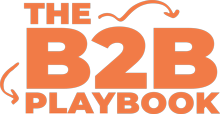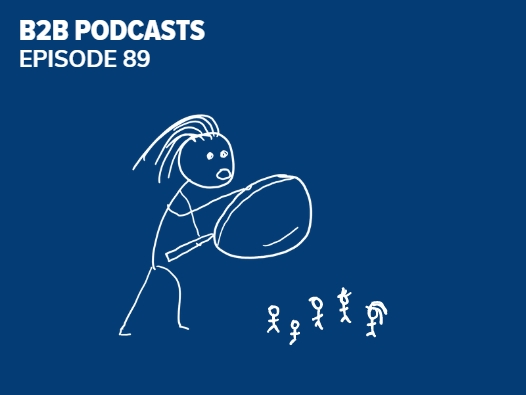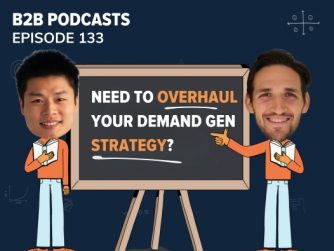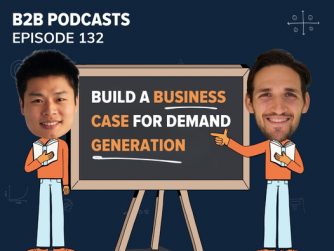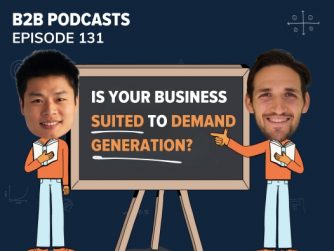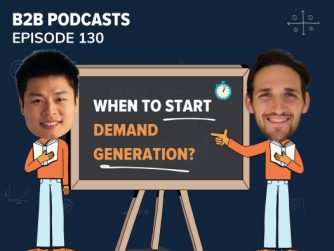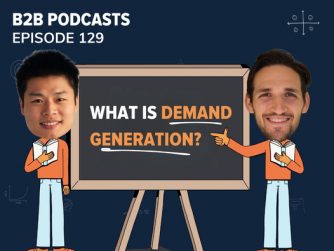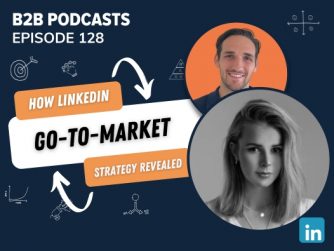The best B2B marketers collect and ACT on customer insights. But how do you actually do it?
In this episode, we show you first HOW to conduct a customer interview, and then how we use those insights to adjust our marketing strategy and tactics.
You’ll also learn about how our demand gen program ‘The B2B Incubator‘ has helped marketers in small teams.
🎧 Listen to the episode and learn:
- How to collect customer insights
- How to analyse them to adapt your marketing strategy
- What a live customer interview looks like
- Why B2B marketers in small teams love The B2B Incubator
- How to update your positioning and messaging
Watch The Episode
Transcript
[00:00:00]Shahed Intro – George Side: The feedback that we’ve got from a lot of participants is, That this is not just a great program for them to use right now, but they feel like it’s a framework that they want to use in their marketing careers, from now on. So they’ll still be using it in 2, 3, 5, 10 years time.
Welcome to the B2B Playbook. We built this channel for small B2B marketing teams who wanna drive more revenue for their business. Every week, we’re showing you how to create more demand for your brand, step by step using our five feeds framework. So if you are time poor resource strapped, but you still wanna make a big impact on your business, make sure you hit that like and subscribe button down belows to you.
Don’t miss an episode.
Shahed Intro – George Side: Welcome back to the B Playbook. This week, Kevin and I changing it up a little bit. Listeners and viewers, we’re actually gonna show you how we conduct customer interviews and then how we take that information from. The interviews to make our marketing and product better. It’s something that I know a lot of people struggle with.
It’s something that I think a lot of people want more information on. And and [00:01:00] actually Kev fits really nicely into where we’re at in season four of the B2B playbook.
Shahed Intro – Kevin: Yeah, that’s right. Be better. It’s all about optimizing your B2B marketing workflow, and that’s exactly what this is all about. We’re showing you our workflow, how we refine it, how we take insights from it, and how we make our product better. So let’s get into it. Now that we have regular marketers going through our program the B2B incubator, we schedule a 30 minute call with each of them on completion to understand as much as possible about how the experience was and get that feedback from them directly on our marketing and our program.
What Is The B2B Incubator
Shahed Intro – George Side: Alright, Kev, and for those who don’t know the B2B incubator, it’s actually our product. A lot of people don’t even realize that we have one because we don’t speak about it that much. The B2B incubator, what is it? It’s a program that’s designed for B2B marketers who are in small teams who want their marketing to make more of an impact in their business.
It helps them build a demand engine so customers come to them when they’re ready to buy and not the competition. [00:02:00] Over 12 weeks, we give marketers the strategy, the templates, and the tools to build and start implementing this B2B marketing strategy that leads to consistent growth and continues to compound over time.
A lot of people care if they call it demand generation. So the marketer that we’re interviewing today her name is Shahe and she worked at a B2B SaaS company that was a commuting platform. She’s the only in-house marketer there, and they needed a marketing strategy and a system that the team were on board with that she could consistently execute.
Now, we’ve heard firsthand from Sha Head and the leadership team there that they thought the program was a huge success and they’re executing a lot of it as we speak. So that made her an awesome fit as someone to interview to try and get as many insights from as possible. So this week we want you to listen to each of the questions that Kevin and I ask, and then at the end we’re gonna tell you how we’re using it to improve our marketing and product. I do [00:03:00] want to clarify listeners and viewers that, look, I am not a customer interviewing expert. There’s definitely some points where I probably should have dug a little bit deeper in the interview.
But I was conscious of time and I wanted to get as much out of it as possible.
Shahed Intro – Kevin: Yeah, listeners, if you have the luxury of being able to engage in an expert, we can definitely recommend some people for that. We’ve had people on the show for that exact purpose. But in the interest of running one man bands in terms of the marketing team like George and myself are. We have to do the best we can and we’ll just have to plow on and improve over time without interviewing skills as well.
So don’t let that, don’t you take our example as if we can do it, you can do. But what we really want to show you and have you extract from the interview in this episode is can you get those big feedback points out of that conversation? For example, we were really looking for the biggest benefits to Shahad [00:04:00] personally.
We’re hoping to understand the biggest benefits to the organization as well, and then we wanted to understand some of the outcomes and best features of the program. And we then wanted to understand how it helped her do her job better. What were the biggest pain points that she experienced prior to joining and why she ultimately decided to join.
All of these things will obviously help us to improve the program as we currently have it.
Start Of The Customer Interview
Shahed Intro – George Side: All right, listeners and viewers. With all that said, let’s kick into the interview.
What Were You Looking For When You Signed Up For The B2B Incubator?
Feedback – George: What were you looking for when you signed up for the B2B incubator? If you can describe, any pains that you and the business were feeling, that would be amazing.
Feedback – Shahed: Absolutely. So when I joined the business they definitely had a good idea of who their dream customers were. And they knew that the, like our businesses product solve problems for different. Industries or niches, but it was really hard to put it all together.
The business had tried [00:05:00] marketing strategies that were fragmented and as it’s common for every like business that usually will just try out like ads and then will have a social media strategy and things like that.
Like it’s very common for every business to do this, but it’s really not so common to Kind of intentional all these strategies and make them intentional. I also came from like an entertainment heavy marketing background. And like I had experience working with brands and like brand activation, but not really B2B and SaaS and most specifically like transportation, demand management.
So I started like personally seeking out for support in my B2B marketing journey to help me support the business mission and goals in marketing. So I was looking at LinkedIn. I went LinkedIn typed in B2B marketing just to see what’s going on. What are people talking about right now in real time?
Who are the leaders that are [00:06:00] popping up and getting all the comments and likes and what are their thoughts on marketing right now? So I was like, Getting information, seeking out like key words. That’s where found out about like lead generation, demand generation. So all these like B2B marketing words were starting to Pop up in my sphere and I was like, okay, this is the kind of stuff I need to learn.
I found you speaking on B2B marketing on LinkedIn. So I was like, okay, George is saying things that are really aligned with, so I’m gonna follow him. So I followed you and I had your as a resource in LinkedIn. And then I went, there were like a couple other like B2B marketing resources outside of LinkedIn.
I looked at. But yeah, so when I, when I saw that you were also posting about The B2B Incubator in your posts that was cool to see that like you had a thing to support marketers. I checked out the incubator. It was super aligned to what I wanted to learn. And I saw like the the five Bs and how, there was like an intentional [00:07:00] strategy from start to finish and I thought that, A super helpful way for me to structure what me and my business wanted to do for 2023. That’s why I signed up for The B2B Incubator
Why Did You Choose The B2B Incubator Over Other Alternatives?
Feedback – George: What was it that made you go with the B2B incubator over these other alternatives?
Feedback – Shahed: I felt like it was more. now. I trusted it more like I felt like your information was current. And then it was so personable. Like it was you, what you, the thing that you were offering, the product that you were offering was more personable. I felt like I could learn easier from you than if it was one of these courses that felt maybe more alienated. If I had questions like like I really love the one-on-ones because I was able to ask you questions in real time and get feedback in real time and that was super helpful. And then when I was stuck with a challenge, I had that in my mind that I was like, oh, I’m gonna talk to George about this.
So I really like that personal personality. And then also I just felt like [00:08:00] the information was more current and just like it was now. It’s like what people are doing now, what marketers are doing now.
What Have Been The Biggest Benefits Of Going Through The B2B Incubator?
Feedback – George: For you personally, what have been the biggest benefits of going through The B2B Incubator?
Feedback – Shahed: I think the structure, I’m someone who like needs structure. So I think you breaking down marketing in that way, like even for someone who’s been doing it for so long or has been doing it like not that long like I’ve been doing marketing for so long, but I haven’t been doing B2B for so long, like it was I loved like restarting okay, forget everything, and here’s the structure that you need to follow.
I love that so much. So start from finish structure and then the templates were super, again, it’s also with the organization, having someone to provide me, like this structure. What, and then I can plug and play from like information I have and information I can act on. Was super helpful.
How Has This Made You Feel More Confident In Your Job?
Feedback – George: Awesome. A lot of marketers we that go through the program when we speak to, and just a lot of marketers [00:09:00] in general, often feel like they have some kind of imposter. Syndrome or don’t fully have confidence in what they were doing. Was that something that you were experiencing at all?
Feedback – Shahed: Absolutely. I think I think so because I definitely came into the role super confident. And then when things wouldn’t work and then we paused them I think there would be like a kind of like a snowball effect of okay I haven’t seen personal results in so long in my role so I must be doing something wrong.
So I think to restate, reset and do a forget everything you know and do the structure is Good for people for people who are struggling, but they have the information, they just need like a structure. And then also the tools like you in the templates, you would give examples of tools to use.
So you would say okay, here are like channels that you can do. And then you would put examples of the channels and why. And then [00:10:00] for the podcast, for example, you would say for the B2B incubator for the B2B podcast that we do. Here are the tools we use and here’s why. And you had that graphic of Riverside and Descript and and so that was for me, helpful to note down oh, I can use Descript.
So that also was like really good, like supportive.
What Were The Main Benefits To The Organisation?
Feedback – George: What are the benefits to the organization from going through this program?
Feedback – Shahed: Streamlining our marketing efforts, I would say, and like making it clear what marketing is doing. For everybody on the team. And I think when I started the program, I had, we had a team meeting. We have weekly team meetings or every other week we have a team meeting with everybody, developers, and everyone says they’re part.
And I, I said that for 2023, we’re breaking it down. We’re breaking marketing in three parts for, we’re spending quarter one. breaking down 2020 three’s efforts. And this is gonna, it’s gonna be in three parts. And I said [00:11:00] we have to be ready, be helpful, be seen. And then I did this like chart of what, how we like our logline like unifies logline from like when we first started to.
Last year and next year’s and saying oh, like we’re honing in on our why and like our messaging and we’re gonna do all these like customer feedback interviews and we’re going to just like really figure out where to put our content. Like I was summarizing the cohort.
Which is good visibility for them to see like what marketing’s going to be doing in q1. And then also, Like I was telling you, George, every week, every time we met, that my boss would ask me a question and I would be going through it at, in the incubator, so I would be answering his question, like in a really nice, structured, detailed way.
So I think I was also like the incubator was like answering the questions at the right time. Yes, they would ask me about okay, what’s. okay, we have her content now. Where are we gonna place it? And I would be like so we have two ways to be [00:12:00] seen and there’s like ABM and there is a paid media.
How Has The B2B Incubator Impacted Your Marketing?
Feedback – George: How has the B2B incubator impacted your marketing?
Feedback – Shahed: I would say it really impacted my marketing strategy. Like I’ve, I’m really taking everything that I’ve learned and applying it to my marketing strategies because it just makes sense to me now. Like it just makes sense to me to structure. It the way I learned the way I, what I learned from the program. So yeah, I would say it’s really it really impacted it and to a way that like, it’s not just me trying to sell it to my team, like even my bosses and my supervisor and then like other people from like product customer developer, like they’re all impressed.
They all like the structure that I’m coming in with.
Feedback – George: What level of marketer do you think that this is best suited to?
Feedback – Shahed: I think all kinds of, all levels because it’s I find it like a, [00:13:00] it really reminds me of like when I went to university and I was a freshman, And the first class I went to for my program, it was like a math class, so it was every like student in first year. And it was for like television.
I went to radio and television arts. And so we were all like, obviously media like fans and thought we knew our stuff, our professor really told us like, whatever, forget it. I think it’s that’s how I felt with the program. I felt like a freshman. And but in, but also in that regard of like imposter syndrome, clean slate.
So that’s, and I was telling you like, oh, I’ve been doing marketing for a while and then I’m also new to b2b. So I feel like both sides benefited, like the one that’s done marketing for a while and the one that’s like new to b2b. Yeah, so I would say like even if I was an expert, like I would say I’m a professional and not a freshman, it was also beneficial for me. Okay.
How Does It Compare To Other B2B Courses Or Resources You’ve Been Through?
Feedback – George: If you’ve gone [00:14:00] through like other marketing programs or other resources, how does this compare to them?
Feedback – Shahed: I would say it goes back to the personal aspect of it that would be missing. And maybe there would also I feel like maybe there would be more information than I need to go through. So I feel like your program was structured in a way where it just gave you the information you needed. And sometimes like you’ll get a course or like you’ll buy a product and there’s just way more things to sift through.
Or like you’ll get a lot of good valuable stuff, but not a good walkthrough. So I think you did a good job at walking through the program.
How Did You Find Our Live Sessions?
Feedback – George: How did you find our live sessions?
Feedback – Shahed: Our live sessions were really fun they were great because I got to, you were asking me about like how it’s been and I would catch you up. So it was nice to every time that we caught up, it was like there was progress. And then it was nice to go [00:15:00] through. The exercises together and then expand on the exercises, like you would, we would go through on a page and then we would expand on one part of it and you would give me more.
Like we would just get talk about it more. And that I think is like more valuable than doing like a textbook exercise, like an exercise on piece of paper because like you were looking at it and then we were having a bigger conversation about like one thing that’s on that one page from like the canvas template.
And then I was also like editing what with you and that was super helpful. Yeah, the one-on-ones were super helpful actually. That was like the one that I wanted to do.
Was Filling Out The Strategy Template As You Go Useful?
Feedback – George: Fantastic. It was a lot of fun. I really enjoyed them too. What about the, I guess the Canva template on the one side, so that overall strategy document, filling that out as you went, did you find that to be a useful part of the program?
Feedback – Shahed: Yeah, absolutely. I love the [00:16:00] Canva template. I love like watching the exercise on the The B2B Incubator. And then Seeing you go through the exercise and I’m like, okay, now I like, now I have, now I went through that session and I’m like, I’m amped to fill out my own, like my own paid media channels or like social media channels.
And then I like that you made it customizable for the marketer. Like you’re made it so that it’s like a report to give to the team. So yeah, they’re super useful. Linking the sheets to the template is also super helpful.
Especially also with if I was doing a report to my team, I’ll be like, and then this is expanding here’s the content scheduler and then go to the sheets from the template.
Were Other Templates Like The ABM Template and The Dream 100 Template Useful?
Feedback – George: did you find those other templates helpful too? Like the ABM template, the Dream 100 template, that kind of stuff.
Feedback – Shahed: Those templates were super helpful and they were like a crowd pleaser with the whole team. Like from the feedback interview questions. Man, they [00:17:00] gave me like gold stars for months, like people were. So impressed because it really juiced out valuable information from customers that like, again, we like guessed in our heads or had ideas or felt or had intuition of like how things were going with their customers, but didn’t really know and didn’t even record their thoughts anywhere.
And so no one really knew what to expect from these customer interviews. But when we were like asking these questions and they were just like, So many like valuable things and like product feedback. The product feedback was where I was like, oh, this is gonna be a crowd pleaser. Cuz I went back to my my C T O and the developers, the product team, and I like told them like, Hey, the existing customers love our product so much.
And by the way, here are like the things that they like, want want improved on and they’d be like, oh, this is like an easy thing to improve. Like word, we got it and like our customer would be happy. And so they were [00:18:00] happy to have that synchronicity. And the other templates, like also with the ABM and the social media.
The, just all the templates and then even the independent one that you gave me with, that you provided with like more marketing things that can support the B2B program strategy. That was super helpful. Like also a crowd pleaser with me in the. And my supervisor. And then also because they do synchronize the team, like they do synchronize the product team and the CRM and the sales and then provide visibility to my c e o.
He’s such a numbers guy, so he loves that. One of the paid ad templates, the one that has all the revenue and ROI and things like that. So it’s great visibility for him to see what marketing’s doing. And yeah, so the templates are golden. They’re super valuable.
Has The Program Given More Clarity On How Your Content Strategy Helps Create Demand?
Feedback – George: Awesome. Do you feel like the program has given you perhaps more clarity on, how a content strategy fits into creating demand for your brand
Feedback – Shahed: [00:19:00] yeah, absolutely. 100% I feel like I’ve walked out with knowledge that I was, that was absorbed. So fun and casually that it’s like water cooler talk. Like I sound so cool talking to my friends now, like I’ll just be like, my friend was talking about wanting to do a podcast and then I was like, oh yeah, so your podcast is your pillar content and then you can do your blog to Repurpose, I swear.
And they’re like, oh my God, I need to write this down. And yeah, and I would be like, oh, you should use Riverside. Things like so yeah, it’s been like it’s made me sound so, so smart. So
What Were The Most Useful Features?
Feedback – George: What were the best parts or the most useful features of the program?
Feedback – Shahed: There’s a bunch of best parts, like the templates for sure. They really helped organize, information and thoughts and structure. The videos, the walkthroughs of the cohort was a really good way to absorb the knowledge, the information the exercise templates [00:20:00] and like visually too.
Made it also fun, made it want, made me want to take part of the exercise because if it was like a boring one, I’m sure I would’ve been, like subconsciously unmotivated to wanna do it or something. But I think I made that comment once or twice to you too. I was like, oh I really like this template or something..
Feedback – George: Thank you so much Shahed. Again, it’s been an absolute blast. I’m glad that it’s worked out for you guys, and as I said, really looking forward to our three month catch up.
Turning Customer Insights Into Marketing Actions
Shahed Intro – George Side: Wow, Kev, that was a very complimentary interview, I have to say. I promise that we didn’t solicit that. Shehab was not paid to do it. In fact, she paid us to be part of the program, of course. So everything that she said were her own words. Very kind of her. She was a fantastic participant and I’m glad that she got so much out of it.
But, we’re not here to congratulate ourselves. We wanna talk about now, Kev, the information that she shared with us and how we’re actually going to use that [00:21:00] information to further improve our own marketing for the B2B playbook, the B2B incubator, and actually improve the product itself too.
Shahed Intro – Kevin: That’s it. I think the first one we can look at is how we use those insights to map the buying journey. So the first piece of insight that we got and that we could really start to utilize in our own product marketing is that we looked at her buying journey and we tried to map the experience of new potential members of the course to that journey. So her journey in this particular case was looking for B2B marketing leaders.
She found us on LinkedIn through that process of looking for B2B marketing leaders. She followed our posts, listened to a few podcast episodes, and then eventually saw the B2B incubator, which she then bought when she was ready. So knowing all that, first off, it’s great to know that what we’re doing is working.
So that’s exactly how we planned the different channels and we hope that it would have that impact. And it’s great to have that validation. So that’s actually [00:22:00] less of a self-congratulatory point, but more that it’s a validation that what you’ve planned is working. It’s a signal that what you have planned is in fact coming off.
And it’s a good sign, obviously to take forward. We’re also trying to cover each of those touchpoints a bit better in the customer journey in the future. So we’re making sure the touchpoints that you had touched on were still appearing in those touchpoints and we’re trying to improve on increasing those touchpoints.
Shahed Intro – George Side: Yeah, spot on, Kev. Let’s go back to the, not the good old days, the bad old days, where we try and piece together this customer journey by just diving into Google Analytics. And I’d probably pull through like a, Page visitors report, whatever it’s called in there. And I just wouldn’t have be able to piece this together.
You’re trying to guess it. You’re trying to pull some sort of funnel out of the metrics there. But my God, it was so easy to just ask her. And now I know that her initial touchpoint was like looking for B2B marketing leaders because she wanted to start learning from people.
[00:23:00] So she obviously had a problem at that point. She wasn’t like problem unaware, she was problem aware because she’s like, I need to get by better at B2B marketing. I want a more holistic marketing approach. And it’s awesome to know that she was looking for that on LinkedIn. And it’s even better to know, Kev, that.We were people who popped up as experts in that space. So tick there for us that we appeared in the right space. Then she followed our posts and she said that she actually saved a whole lot of our posts. Over time she was following us for quite a while, so tick for relevance. I guess for our content care, we know that it’s truly helping our dream customers, especially if they’re saving our posts.
It’s something that they want to follow on and enact Later, they listen to the podcast episodes, or sorry, she listened to the podcast episode, which is. Fantastic. This is like a big effort for us. Of course, it’s the main driver behind our content, but it takes time to create these podcasts. It takes time to edit them.
So great to verify that’s another important touchpoint in the journey. And then finally she saw the B2B incubator, so we [00:24:00] mapped her needs to our product. So I suppose a tick there. I think it did take her a while to get awareness around the B2B incubator. And we have said that the B2B incubator isn’t something that we speak about a lot, so that’s probably something to improve on.
Shahed Intro – Kevin: Yes. Lots of great insights there. Just from that simple understanding of the journey and what we can do to influence it from our side to make it better for our potential end users. The second great point, second great thing that we could do with the insights that we gleaned was to update our positioning and unique value propositions.
So April of Dunford defines positioning as how your product is a leader in delivering something that a well-defined set of customers really cares a lot about. And so for the B2B incubator, we really wanted to provide marketing managers the strategy, templates and tools to generate demand, drive more revenue, and prepare the teams for scale.
Updating Our Marketing Positioning
Shahed Intro – George Side: And Kev, that’s how we had imagined that we should have positioned ourselves originally. Of course, you can refine your positioning and [00:25:00] change it over time. What’s really interesting, Kev, was she head in the customer interview? She actually compared us to other more formal education systems.
I dunno if you remember listeners, but she noted that she felt like a freshman. Starting over when she got into the program. So comparing it to like tertiary education. But she said that it differed from formal learning because we just gave her exactly what she needed. It wasn’t like, didn’t go over a whole semester.
There wasn’t a whole lot of useless information. It was like, this is just what you need, go and use it. But nevertheless, she did compare us to a tertiary education system. She also noted, Kev, that she really liked the support of the live sessions. Now, if we receive more feedback like this Kev, where people start talking about us in terms of like more a tertiary education system, maybe. We can test positioning ourselves as an alternative to a formal marketing degree, the same way that Mark Ritson has with his mini mba, which is like a more generalist marketing program for those who [00:26:00] don’t know.
Ours in contrast is very action based and very outcomes focused. So at this stage, I am reluctant Kev to position ourselves as like a tertiary educator but interesting nonetheless.
Shahed Intro – Kevin: Yeah, we agree with that, George. I think our listeners know we’re very much practical advice focused. We’re much more practical compared to some of the theoretical understandings that are espoused out there.
And so I’d be also hesitant to move towards a mini MBA definition of our program. It’s really more of a practical guide to how to get started and we’re there to help you in that process. And really we hope that as people get through the program, they actually. Implementing all the things that we’re talking about in the program in real time as we go through it or as close to real time as possible so they can get the maximum amount of learnings from the program.
So agree with you there, George, but it is definitely a really good insight and something that potentially we can start to talk [00:27:00] to people about to help them better understand what the impact of our program could be.
Shahed Intro – George Side: Yeah, look, it certainly wasn’t like a major point of hers. I just thought it was an interesting thing to pick up on the language there. And perhaps if it was something that we started hearing again and again maybe like we start to use. The marketing degree as the enemy the alternative enemy that shortchanged so many of our listeners didn’t give them what they needed to actually do their jobs well.
So maybe we’re not positioning ourselves as an educator, but we’re just picking up on that language. And then we’re, forming it into part of how we’re positioning ourselves or at least into our own messaging. We mentioned unique value propositions to Kev. That’s something that we can start to pull out from these customer interviews.
For those who don’t know unique value propositions, they’re how you explain the benefits of your product. In other words, why would someone do business with you over your competitors? Now, Kev, you and I actually have a document where we list all the features and benefits of our product, and every time we do a customer interview I’m just jot down [00:28:00] every time one of these is mentioned.
For example, people mention the templates in the program. They mention how great it is to create the ideal customer profile through the program. They talk about the frameworks, they help them, leaders and manager. They talk about how it gives ’em the foundations for scaling content that sets you up for success.
They talk about how it supports their paid acquisition strategy. They talk about how the group sessions really motivate the participants to get stuff done. The list goes on and on. And Kev, whenever we do these customer interviews, we actually go through and jot down against each of these, which one was most important to them.
So over time we can see, hey, of all the features and benefits that our program provides, which are the top three to five most important ones to our dream customers. And they’re our unique value propositions. They’re the ones that are unique to us. They’re better than the competition and the ones that we wanna work into our marketing messaging more and more.
So these customer interviews are so valuable in giving us that information now for ahead. I think she really [00:29:00] mentioned the documentation of the program as well as the frameworks that you get and the ideal customer profile creation. She also really liked the templates, so they were the key sort of three or four things that really made this program a home run for her.
And that’s something that we probably wanna emphasize in our message because Sha head is a dream customer of ours.
Shahed Intro – Kevin: Listeners, aside from the fact that you can get all these insights from these customer interactions, from these customer interviews, You are, you might already know that following along with the podcast, you might already know that might be done and be ready or be helpful to understand some of these points.
But in Be Better, what we really want you to focus in on is, yes, you should be doing this after every single interview, and you should have a process like we do in place, but it can be as simple as. A big old list in Google Sheets or something like that, similar to what we have. As long as you have somewhere where you’re recording this information, you can [00:30:00] always tidy that up later.
You can always improve that process later if the time warrants it, if the time to actually improve that pro process and the payoff that comes from that warrant set. But just make sure that you have that process in place and you make sure you’re documenting that process somewhere, including listening down your USPS that you’re getting from these customer interviews so that over time you actually have that data there for you to utilize when you get round to improving your process.
Shahed Intro – George Side: That’s it, Kev, and I promise that I’m actually documenting it. You can see it. It’s a little messy. It’s not perfect. I know it’s not perfect, but we are documenting it and it is something that we can act on, and the more data we collect, the more that we can act on it.
Shahed Intro – Kevin: it’s just about being better, isn’t it, George? We’re not saying you have to be perfect, just be a little better every day, and you’ll quickly get to hitting your objectives.
Updating Our Unique Value Propositions
Shahed Intro – George Side: That’s it. That’s it. I’m just trying to be a little better, a little more organized for you, Kevin. Okay. Updating our messaging. That’s something that you definitely want to do, [00:31:00] especially if you’ve revised your positioning and or reconsidered perhaps the priority of your unique value propositions. I’m not sure that we really have after this interview, Kevin. I think we’re pretty close to knowing already what Shahab would get out of it, which is great because I think we already have that close alignment with that dream customers. But if we did wanna reorder like the unique value propositions we would then like really take that information and update that messaging on our B2B incubator landing page.
If. Shahe told us that her pain points were like X, Y, Z, and we had them listed as a abc, then we definitely wanna update those to reflect that on the landing page. If our LinkedIn doesn’t reflect our positioning we definitely want to update that. My personal profile, your personal profile, the B2B playbook profile, we wanna update all of that kind of stuff.
If. The main benefits that she got out of the B2B incubator weren’t reflected on our LinkedIn post. When we talk about the B2B [00:32:00] incubator, then we definitely need to rethink that. We need to really hit home those important key things that she got out of the program when we discuss the B2B incubator on LinkedIn.
So make sure you take that information and you actually roll it out across your messaging on all your different platforms.
Shahed Intro – Kevin: Again, it’s a process that you should consciously and actively work on. Obviously in this case. It’s one interview so you know, it’s taking into consideration with the interviews that we’ve done and on balance. We haven’t changed a lot recently off the back of this one particular interview, but certainly you can see how listeners and viewers, you can take those insights and you can apply it to your particular business to update your messaging.
And I would encourage everyone to do that sub subconsciously because subconsciously as we go through the analysis of these interviews, as we listen back on them we will pick up on different things. And when George and I next look at the content calendar, we’ll start to automatically focus in more on the things that come up more.
But that is very [00:33:00] subconscious. That is maybe a little bit more hit and miss and on our gut feeling than we would like. And it’s important to build a process around that as well. And that’s what we’re really talking about here.
Shahed Intro – George Side: That’s it all about building a process. And Kev as part of that, from the insights that she had gave us, we can actually start to use that information to try and improve the product. She had an awesome idea around having a community for alumni of the B2B incubator. So once you’re actually done with the B2B incubator, can we have everyone in an alumni group where they discuss how they’re continuing to implement it, this in their business?
The feedback that we’ve got from a lot of participants is, That this is not just a great program for them to use right now, but they feel like it’s a framework that they want to use in their marketing careers, from now on. So they’ll still be using it in 2, 3, 5, 10 years time. So having an alumni group could be a really great thing for these people to continue to engage in that.
When she mentioned the alumni Kev rather than thinking about, oh, what [00:34:00] platform should we host it on if we do this alumni program? I just straight up asked her like, what platform is it that you hang out on most that would be really good for this?
And she suggested a couple which is really useful. Look, to be honest, Kev, we didn’t really have the resources to support a group like that. It’s not enough, as we know from speaking to Katie Ray on that episode around community, it’s not enough just to be able to create a place for people to get together.
It’s work. It’s actually work, maintaining that community, making sure that everyone’s getting value from it, making sure that there’s no nasties in it and we just don’t have the resources for it. But, we’ve put that idea in our product development doc and it’s something that we’d love to do one day.
Shahed Intro – Kevin: That’s it. And it’s great to get those ideas from these conversations. Listeners, you can see that you can actually get a lot of your product ideas from these conversations. You don’t need to go out there and reinvent the wheel. A lot of the times. The wider team the wider community who’s engaging with your product will have these ideas for you, and it’s helpful that they can give you some prioritization as [00:35:00] well, depending on how many people are requesting different things.
And of course we also asked how can we improve the program. Now she was very kind and she didn’t have too much for us here. Just that she never really got the company invoice, which is quite funny and maybe something we should work on getting better as a process. But obviously it’s a great opportunity towards the end there for you to get that insight as well into how you can keep improving the program direct from the horse’s mouth.
Shahed Intro – George Side: Yeah. Kev, I’m gonna portion 50 50 blame there between you and me. You are our process guy, and I’m the one who probably should have done it. So 50 50. Blame there.
Shahed Intro – Kevin: Yeah, no. Definitely something that we can improve in our internal processes there. But she was very kind indeed to point that one out for us.
Key Takeaways
Shahed Intro – Kevin: All right, listeners, key takeaways for this episode. You need to regularly schedule these interviews with your customers and have a process for documenting and acting on the information you get from them.
It’s okay to refine [00:36:00] and change your positioning and messaging over time as you learn more about why customers love your product or maybe why they don’t. And the B2B incubator has helped marketers like you already. So what are you waiting for?
Shahed Intro – George Side: Very good, Kev. Nice little plug there. Full disclosure listeners, I wrote those key takeaway aways. I just forced Kevin to do some promotion for us, which he would hate. Anyway, listeners, viewers, you can always find links to everyone. Everything that we discussed in the show notes, and Kevin and I are so grateful that each week more and more marketers are tuning in every Monday morning by listening to the podcast and watching us on YouTube.
And if we can ask just one thing, it would be to please leave us a short review or comment on whatever platform it is that you listen on or pass it on to someone who you think would really get value from the show. It’s a huge help to whoever comes across it in the future, and we really appreciate it.
Take care. Thank you, Kev. A huge thanks to Shahe. Thank you, dear. Your listeners, catch you next week.
Shahed Intro – Kevin: Thank you listeners. Thank you, Shahad. [00:37:00] Thank you, George, and catch you all next week.
Shahed Intro – George Side: Everybody’s so thankful.
